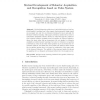Free Online Productivity Tools
i2Speak
i2Symbol
i2OCR
iTex2Img
iWeb2Print
iWeb2Shot
i2Type
iPdf2Split
iPdf2Merge
i2Bopomofo
i2Arabic
i2Style
i2Image
i2PDF
iLatex2Rtf
Sci2ools
IROS
2008
IEEE
2008
IEEE
Mutual development of behavior acquisition and recognition based on value system
Abstract. Both self-learning architecture (embedded structure) and explicit/implicit teaching from other agents (environmental design issue) are necessary not only for one behavior learning but more seriously for life-time behavior learning. This paper presents a method for a robot to understand unfamiliar behavior shown by others through the collaboration between behavior acquisition and recognition of observed behavior, where the state value has an important role not simply for behavior acquisition (reinforcement learning) but also for behavior recognition (observation). That is, the state value updates can be accelerated by observation without real trials and errors while the learned values enrich the recognition system since it is based on estimation of the state value of the observed behavior. The validity of the proposed method is shown by applying it to a dynamic environment where two robots play soccer. Key words: Reinforcement Learning, Behavior Recognition, Value system, Lear...
Behavior | IROS 2008 | Observed Behavior | Robotics | State Value |
Related Content
| Added | 31 May 2010 |
| Updated | 31 May 2010 |
| Type | Conference |
| Year | 2008 |
| Where | IROS |
| Authors | Yasutake Takahashi, Yoshihiro Tamura, Minoru Asada |
Comments (0)

